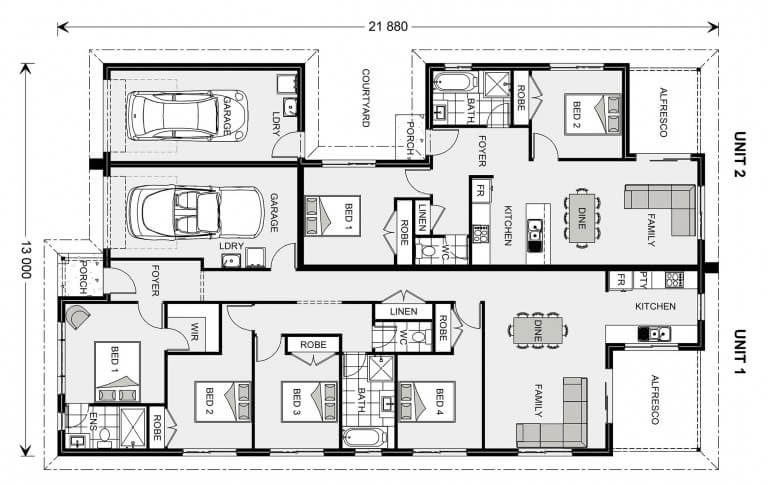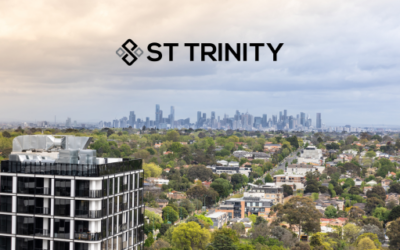Stepping into the world of home ownership is a significant milestone. For first home buyers, the journey can be both exciting and daunting.
One option that is gaining popularity in the real estate industry of Australia is dual occupancy homes. These properties offer a unique blend of investment potential and lifestyle benefits to its investors.

Anyone willing to invest in dual occupancy homes or even the first home buyers should deeply understand the terms and conditions relating to dual occupancy homes, and the financial implications of dual occupancy homes are very crucial.
We’ll explore what makes dual occupancy homes so appealing, define the concept, and guide you through navigating their floor plans, and so on.
Whether you’re considering a dual occupancy home in Melbourne, Brisbane, or Perth, this guide will equip you with the insights you need.
Let’s embark on this journey together.
Table of Contents
Understanding Dual Occupancy Homes
Dual occupancy homes offer a special housing option where two separate dwellings share one piece of land.
These homes can be attached or detached, depending on the design and local regulations. The key feature is that each dwelling operates independently.
This independence offers a range of benefits. For instance, you can live in one dwelling and rent out the other.
- Dual occupancy homes offer potential rental income
- They provide a solution for multi-generational living
- They can maximise the value of a single block of land
Understanding these benefits is the first step towards making an informed decision about dual occupancy homes.
The Appeal of Dual Occupancy for First Home Buyers
For first home buyers, dual occupancy homes present a unique opportunity. They offer a way to enter the property market while also generating rental income.
This income can help offset mortgage repayments. It can make home ownership more affordable and achievable.
Dual occupancy homes also offer flexibility. You can adapt the use of the dwellings as your lifestyle needs change.
Whether you’re starting a family or planning for retirement, dual occupancy homes can cater to your evolving needs.

Source: Lily Homes
Dual Occupancy Meaning and Definitions
The term ‘dual occupancy’ refers to a property with two dwellings. These dwellings can be attached or detached.
Each dwelling has its own facilities and operates independently. This means they each have their own entrances, kitchens, bathrooms, and living areas.
Understanding this definition is crucial when considering dual occupancy homes. It helps you grasp the potential and versatility these properties offer.
Navigating Dual Occupancy Floor Plans and Designs
Dual occupancy floor plans are designed to maximize space and functionality. They are carefully crafted to ensure each dwelling is self-contained and comfortable.
These floor plans can vary greatly. They can be tailored to suit the specific needs and preferences of the occupants.
For instance, one dwelling might be larger than the other. Or, both dwellings might be of equal size.
The key is to find a floor plan that aligns with your lifestyle and future plans. Here are some factors to consider:
- Number of bedrooms and bathrooms
- Open plan or separate living areas
- Outdoor spaces and gardens
- Parking arrangements
- Accessibility features

Source: G. J. Gardner Homes
Maximizing Space with Smart Design
Smart design is crucial in dual occupancy homes. It ensures each dwelling is functional, comfortable, and private.
For instance, soundproofing can be incorporated to minimize noise transfer between dwellings. Similarly, strategic placement of windows can enhance privacy.
Outdoor spaces can also be designed for shared or separate use. This can foster a sense of community while maintaining independence.
Ultimately, the goal is to create a dual occupancy home that feels spacious, private, and homely.
The Role of Zoning and Council Approvals
Zoning regulations and council approvals play a significant role in dual occupancy developments. They dictate what can be built and where.
For instance, some areas might only allow attached dual occupancy homes. Others might permit detached dwellings.
It’s crucial to understand these regulations before purchasing a property for dual occupancy. This ensures your plans are feasible and compliant.
Financial Considerations for Dual Occupancy Homes
Dual occupancy homes can be a financially savvy choice for first home buyers. They offer the potential for rental income, which can help offset mortgage repayments.
However, it’s important to consider all the financial implications. These include the cost of construction, ongoing maintenance, and potential tax implications.

For instance, if you rent out one dwelling, you may need to pay capital gains tax when you sell. It’s crucial to seek advice from a financial advisor or accountant to understand these implications.
Here are some key financial considerations:
- Cost of land and construction
- Potential rental income
- Ongoing maintenance costs
- Tax implications
- Resale value
If any property investor is willing to invest in dual occupancy homes and expecting rental income from dual occupancies, according to a study from Heaps Good Homes, a property investor can expect up to 8% of rental yield from a dual occupancy home.
First Home Buyers Grant and Other Government Incentives
First home buyers may be eligible for various government incentives. These can significantly reduce the cost of purchasing a dual occupancy home.
For instance, the First Home Buyers Grant offers a one-off payment to eligible buyers. There are also stamp duty concessions and the First Home Loan Deposit Scheme.
Each state and territory has different incentives. It’s important to research what’s available in your area and whether you’re eligible.
Remember, these incentives can make a significant difference to your financial situation. So, it’s worth investing time to understand them.
Financing Your Dual Occupancy Home
Financing a dual occupancy home can be more complex than a standard home loan. This is because you’re financing both a land purchase and a construction project.
Some lenders offer dual occupancy home loans. These are specifically designed for this type of property.
It’s crucial to shop around and compare loan options. Look at the interest rates, loan features, and lender’s reputation.
Remember, a mortgage broker can help you navigate this process. They can find the best loan for your needs and guide you through the application process.
Choosing the Right Location and Builder
The location of your dual occupancy home is crucial. It impacts the property’s value, rental potential, and your lifestyle.
Consider factors like proximity to amenities, schools, and public transport. Also, consider the neighbourhood’s character and future development plans.
Choosing the right builder is equally important. They should have experience in dual occupancy projects and a good reputation.
Ask for references and check their previous work. Also, ensure they’re licensed and insured.
Dual Occupancy Homes in Melbourne, Brisbane, and Perth
Dual occupancy homes are popular in major cities like Melbourne, Brisbane, and Perth. These cities offer a range of options, from urban to suburban settings.
Each city has its unique characteristics and market trends. It’s important to research and understand these before making a decision.
Remember, a local real estate agent can provide valuable insights into the local market.
Working with Dual Occupancy Builders
Working with dual occupancy builders can be a complex process. It involves many stages, from design and planning to construction and finishing.
Communication is key. Ensure you have a clear understanding of the process, timelines, and costs.
Remember, a good builder will guide you through the process and ensure your vision is realised.
The Future of Dual Occupancy Homes
Dual occupancy homes are more than just a trend. They represent a shift in how we think about housing and community living.
As urban areas become denser, dual occupancy offers a solution. It maximises land use without compromising on quality of life.
Moreover, with changing family structures and lifestyle needs, dual occupancy homes provide flexibility and adaptability.
Trends and Developments in Dual Occupancy
In terms of design, we’re seeing more innovative and sustainable dual occupancy homes. These homes are energy-efficient, use sustainable materials, and incorporate smart home technology.
There’s also a trend towards multi-generational living. Dual occupancy homes can accommodate this, with separate living spaces for different generations.
Moreover, as the concept of shared housing gains popularity, dual occupancy homes are set to play a key role.
Sustainability and Community in Dual Occupancy Living
Dual occupancy homes can contribute to sustainable urban development. They reduce urban sprawl, promote efficient use of resources, and can be designed to minimize environmental impact.
Moreover, dual occupancy homes foster a sense of community. Shared spaces encourage interaction and cooperation among residents.
However, it’s important to balance community living with privacy. Good design can ensure each unit has its own private space, while shared areas promote community interaction.
Conclusion: Making an Informed Decision
Choosing a dual occupancy home as a first home buyer is a significant decision. It requires careful consideration of your lifestyle needs, financial situation, and long-term goals.
Remember, the key to a successful dual occupancy home purchase lies in thorough research, careful planning, and informed decision-making.
Contact our property experts today to begin your journey with dual occupancy homes.
Frequently Asked Questions (FAQs)
1. What is a dual occupancy home? A dual occupancy home features two separate dwellings on a single piece of land, which can be either attached or detached. Each unit operates independently, offering individual entrances, kitchens, bathrooms, and living areas.
2. What are the benefits of dual occupancy homes for first home buyers? Dual occupancy homes offer potential rental income to offset mortgage payments and provide flexibility for changing lifestyle needs. They also present a unique investment opportunity, maximizing the value of a single block of land.
3. What should I consider when choosing a dual occupancy floor plan? Consider the number of bedrooms and bathrooms, whether you prefer open plan or separate living areas, the availability of outdoor spaces and gardens, parking arrangements, and any required accessibility features.
4. What are the financial considerations for dual occupancy homes? Key financial considerations include the cost of land and construction, potential rental income, ongoing maintenance costs, tax implications, and the property’s resale value. Consulting a financial advisor is recommended to understand these factors fully.
5. What government incentives are available for first home buyers? First home buyers may be eligible for various incentives such as the First Home Buyers Grant, stamp duty concessions, and the First Home Loan Deposit Scheme. Each state and territory offers different incentives, so it’s important to research local options.
6. How do I finance a dual occupancy home? Financing a dual occupancy home involves securing a loan for both land purchase and construction. Some lenders offer specific dual occupancy home loans. Comparing loan options and consulting with a mortgage broker can help you find the best deal.
7. What should I look for when choosing a location for my dual occupancy home? Consider the proximity to amenities, schools, and public transport, as well as the neighborhood’s character and future development plans. The right location impacts property value, rental potential, and your overall lifestyle.
8. How do zoning regulations and council approvals affect dual occupancy developments? Zoning regulations and council approvals dictate what can be built and where. Understanding these regulations ensures that your dual occupancy plans are feasible and compliant with local laws.
9. Why is smart design important in dual occupancy homes? Smart design ensures that each dwelling is functional, comfortable, and private. Incorporating features like soundproofing, strategic window placement, and well-planned outdoor spaces enhances both privacy and community living.
10. What trends are emerging in dual occupancy homes? Trends include energy-efficient designs, sustainable materials, smart home technology, and accommodating multi-generational living. Dual occupancy homes are becoming popular as they offer solutions to urban density and changing family structures.




